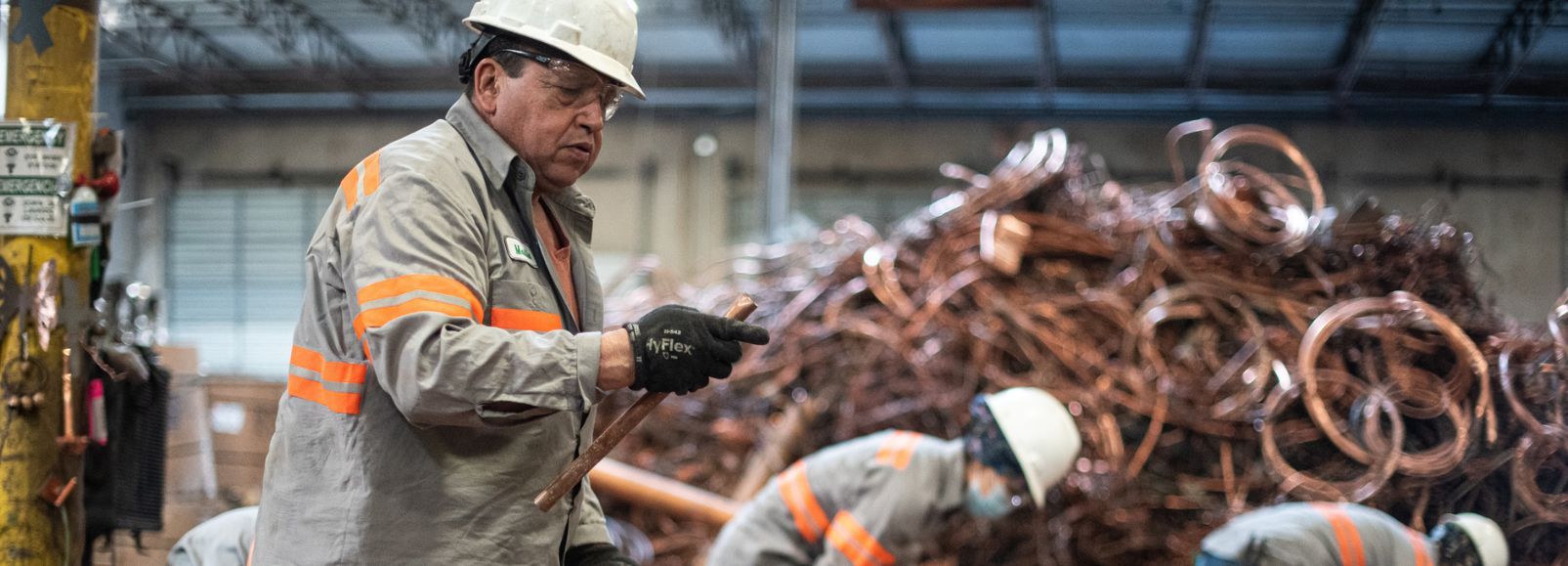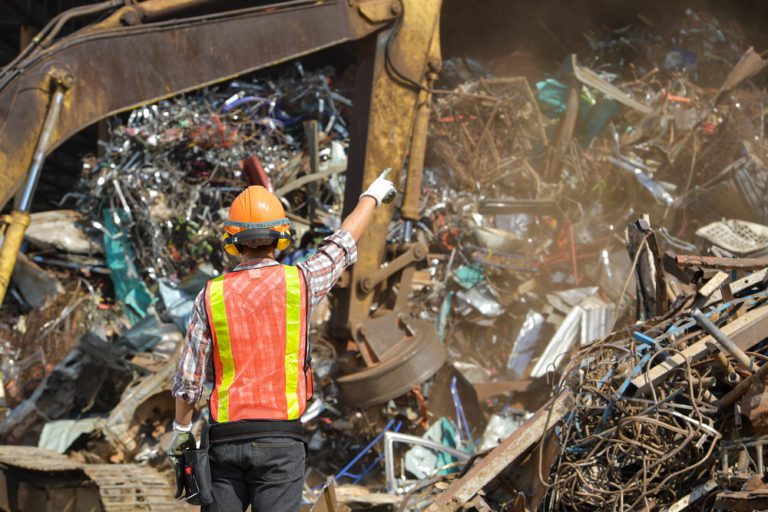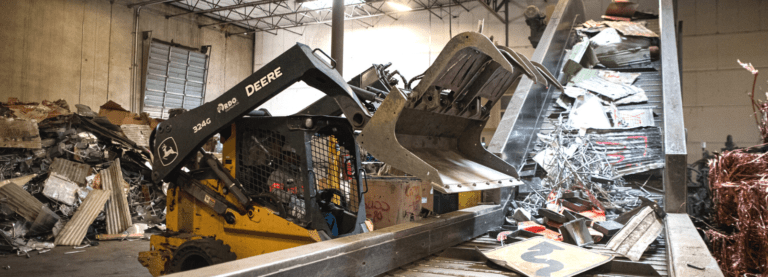As the circular economy gains pace, there needs to be new approaches in the way the metal recycling industry processes recyclable materials. So, what are the biggest challenges that face our metal recycling companies? And is it even possible to change course from age-old procedures?
The new challenges of metal recycling are significant. First, we should embrace the full recovery cycle, i.e., collection, treatment, and reuse. The recycling industry must exploit all waste metal processing to maintain a competitive edge. That means treating and reclaiming more complex materials. Other prerequisites are better waste management and more efficient recycling plants.
This Geomet article explores the six modern challenges and solutions facing the scrap metal industry. But first, an overview of its image and purpose within society.
#1 Improve the Image of Metal Recycling Companies
One challenge is to improve the industry’s image. It’s true; metal recycling is far from glamorous. Indeed, it’s a noisy, dirty business, but someone’s gotta do it. Some complain that scrapyards are a blot on the landscape. And, yes, this is not a clinically clean, quiet industry. That’s why most processing facilities and recycling centers are outside city limits. But their location makes them inconvenient for some recyclers to access.
The Dodgy Image of Metal Traders
Every trade has rogue dealers, and the metal recycling industry is no exception. But over the years, media has portrayed scrapyards and recycling centers as settings for criminal activity or enabling addicts.
However, most metal collection and recycling facilities are honest, well-run, and highly regulated concerns. It’s very difficult to find a major scrapyard or dealer with a “no questions asked” policy. Despite that, metal thieves continue to give the industry a bad name.
New Names for Scrap Traders
The image and status of the scrap metal industry are changing for the better. Even the language is getting a makeover. ISRI (Institute of Scrap Recycling Industries) is creating a new common language for metal recyclers by sunsetting the term “scrap.” Scrappies have become recyclers, and ferrous scrap is better known as green recycled steel. But there’s more behind this upgrade than a new lexicon.
| Economic Impact of America’s Recycled Metal US metal recycling companies are now a $116 billion industry. These businesses dispose of around 260 million tons of metal waste annually, creating 534,500 direct and indirect American jobs[1]. |
#2 Transition to Newer Recycling Technologies
Moving the recycled metal industry to newer, cleaner technologies is challenging but necessary. The technology to process more material faster already exists, including electronic sorting. Accurate 100% machine sorting is still in the future, but sorting technology has come a long way in helping us sort better and more efficiently.
New processing technology and equipment has other benefits, namely:
- Processes metals far more efficiently
- Improved processing speeds
- Enhanced accuracy
- Fewer emissions
Technological advances are vital for increasing recycling rates. It’s also needed to keep up with the changing products and prevent other types of raw material from entering the recycling stream [2].
#3 Get Consumers Onboard with Metal Recycling Companies
Some of the age-old issues concern social behavior and lack of education. Although most metals are infinitely recyclable, not enough material gets reused in the US, and that’s a problem. So, one of the biggest challenges with metal recycling is to get more metal waste into recycling facilities and out of landfills.
There’s also a lot of uncertainty around products and what recyclable metals they contain. One idea is that standardized labels on all items would be more effective than education initiatives. Either way, extra awareness and increased collection rates of discarded products would help solve these issues [3].
Know Your Recyclable Metals
The way to create a closed-loop material system is through education, incentives, and technology. The latter is for the recycled metal industry to sort out. At the consumer level, there are four things you can do to become a better recycler.
- Understand the Basics
- Collect Recyclable Material
- Sort Your Metals
- Sell Your Material
Understanding what materials have value and how to sort them correctly is important. Knowing how to collect and classify metals will make the process much faster and smoother. If you don’t have much, find out the minimum requirement you must bring to a facility.
Individual sellers can be homeowners looking to get rid of old cans and appliances or part-time collectors. Either way, you must separate the metal from other materials as best as possible. Plastic, card, paper, wood, etc., are no use to a waste metal facility. And remember to rinse food containers and other items to prevent contamination in your recyclables.
The more you know about the different metals the better, as it speeds up unloading and sorting. If nothing else, separate your materials into non-ferrous and ferrous metals. The latter contains iron, making it magnetic, so testing your recyclable materials with a magnet is a simple way to sort most ferrous and non-ferrous materials.
Familiarize yourself with current commodity prices if you have a lot to sell. Market conditions cause prices to fluctuate, especially in ferrous metals (see below). When ready, you can head to GEOMET Recycling or your local metal recycling facility. At GEOMET, one of our friendly greeters meets you at the entrance. They then guide you to a drive-up weighing station or unloading dock to weigh your load before paying you a fair price according to the market.
The full recycling process has seven steps, the first three being at the consumer level:
Collect ⇒ Sort ⇒ Sell ⇒ Prepare ⇒ Smelt ⇒ Solidify ⇒ Manufacture
The Inconvenience of Recycling Metal
Many Americans find recycling metal to be an inconvenience. Often the recycling center is not close and has a minimum load necessary to drop off. This can mean storing metal recyclables and not everyone has room at their home to store stacks of aluminum cans or old appliances.
Then there are issues around getting the items to facilities and recycling drops. Bulky and heavy items often require the use of a pick-up truck and strenuous physical labor to load and unload. Many people want to recycle but they don’t have the means to do so.
The Impact of Metal Recycling Companies
It makes sense to embrace metal recycling at every level. Doing so results in new opportunities. It positively impacts both people and the planet economically and ecologically. Our challenge is to reinforce the importance of metal recycling and put its importance in front of its image in the consumer’s mind. And it’s not a hard concept to grasp once you become more “recycling aware.”
The six positives below highlight the real-world advantages of metal recycling in 32 words.
- Conserve natural resources
- Reduce energy consumption
- Keep waste materials out of landfills
- Creates new jobs, directly and indirectly
- Improves the US trade balance
- Lower consumer prices
And don’t forget you can make money by conscientiously choosing to recycle rather than throw away.
#4 Encourage More Recycling and Less Dumping
By now, you know one of the biggest challenges for metal recycling facilities is increasing volume. And that can only happen if more consumers choose to recycle over dumping. Recycling makes sense as you get money for your material instead of being charged for waste disposal. And it’s also the right thing for us to do as citizens.
Private junk removal firms charge from $70–$550, depending on volume. Let’s use an old washer and dryer to illustrate. Combined, they could fetch around $30 in recycling value. Or, you could pay at least double that to dump those items at a landfill. But, of course, metal prices, dumping costs, and removal services vary and fluctuate [4].
About the Fluctuating Price of Recycled Metals
No individual can control the price fluctuations of recycled metals. Factors influencing price are supply and demand, importation, fuel costs, and other market conditions. But it makes sense that the more metal taken for recycling, the lower the costs. That’s one of several reasons why consumers should consider recycling their metal materials over dumping [5].
Metal Recycling Companies Should Involve Small Local Businesses
Another solution for keeping more materials out of landfills is to involve small local businesses. Many companies generate metal waste just like households, only more of it. Offices may discard old metal furniture, kitchen appliances, and various fixtures. While construction, manufacturing, and vehicle industries, etc., generate considerably more.
Like households, it will surprise many businesses how much discarded metal they have once they look for it. And again, it makes more sense to sell the metal than dump it. GEOMET Recycling often works with local businesses to deliver and retrieve roll-off containers for businesses to fill with recyclable materials.
The US Environmental Protection Agency (EPA) is on a mission. Its National Recycling Strategy aims to create a circular economy for all. Are you ready to join the effort [6]?
GEOMET’s High-Quality Metal Recycling Facility
GEOMET buys your aluminum, copper, brass, titanium, steel, and more. We do business with individual sellers, companies, and other metal dealers. After going through high-quality sorting and processing, we ship the processed material to smelters and mills across the US and beyond.
GEOMET is an eco-friendly, environmentally-conscious family-owned company that delivers consistency, trustworthiness, and excellence in all facets of our business.
Learn More About Geomet Recycling
#5 The Carbon-Neutral Challenge for Metal Recycling Companies
The steel industry is one of the main producers of carbon dioxide. But the world needs steel, and the demand will only increase over the coming years. Even so, the recycled metal industry in the US is committed to decarbonization [7].
The chart below illustrates the rise in steel production globally and the leading players [8] [9].
| STEEL PRODUCTION 1950–2020 | MAJOR PRODUCERS 2019 |
| 1950: 189 million tons (MT) 1960: 347 MT 1970: 595 MT 1980: 717 MT 1990: 770 MT 2000: 850 MT 2010: 1345 MT 2020: 1879 MT | China: 1001.3 MT India: 111.4 MT Japan: 99.3 MT USA: 87.8 MT Russia: 71.6 MT South Korea: 71.4 MT Germany: 39.6 Turkey: 33.7 MT Brazil: 32.6 MT |
Decarbonization challenges face steel producers in the US and across the globe. The metal recycling industry and production facilities expect to reduce its carbon emissions 30% by 2050. To achieve this, mills must move some of their steel production away from the traditional blast furnace.
The way forward is using less-polluting induction and electric arc furnaces (EAF) to process low residual recycled steel. The migration to EAF is growing as the industry strives to meet targets by producing green, carbon-neutral steel.
#6 Less Blast and More Electric Arc Furnace
This section examines the pros and cons of blast furnaces vs electric arc furnaces (EAF). There are advantages and disadvantages to each, which is why challenges still exist [10] [11] [12].
Advantages and Disadvantages of the EAF
| Induction & Electric Arc Furnace Pros | Induction & EAF Cons |
| Quick to construct Fast cost recovery Obsolescent waste is the primary source of material Electricity is the main source of energy Can adjust properties in a ladle furnace Lower initial costs than blast furnaces Takes up less space than blast furnaces Quicker to manufacture products The induction-type electric furnace heats even faster | Heavy trucks needed for waste handling Uneven heat distribution High production of the byproduct slag Systems need technical support to maintain power quality |
Advantages and Disadvantages of the Blast Furnace
| Blast Furnace Pros | Blast Furnace Cons |
| Iron ore is the primary source of material Melts iron ore and coke to produce pig iron Converter removes impurities Easy to produce clean steel Used to process several other metals | Coke is the primary fuel and source of energy High investment in facility development Takes up large amounts of space Emits large amounts of carbon dioxide |
Corporate Credits and Fines
The recycled metal industry has many challenges in the US, but there is progress. Companies are starting to tackle old disruptions caused by process inefficiencies. Examples are better inventory, improved supply chains, more transparency, etc. Technology, digitalization, and intelligent optimization are the best ways to meet these challenges.
Governments are helping to incentivize this progress with corporate credits and fines, the proverbial carrot and stick, to motivate companies towards greener practices. And more public awareness and action will help keep the new circular economy on track.
Metal Recycling Resource Links
- https://www.isri.org/-economic-impact-of-US-scrap-recycling/
- https://www.scrapware.com/technology-changing-scrap-metal-recycling-industry/
- https://www.wastedive.com/standardization-lables/
- https://homeguide.com/costs/junk-removal-prices
- https://roanemetals.com/why-do-scrap-metal-prices-fluctuate/
- https://www.epa.gov/recyclingstrategy
- https://www.theworldcounts.com/challenges/impact-of-steel-production/
- https://worldsteel.org/world-steel-production-1950-2020/
- https://worldsteel.org/global-steel-output/
- https://www.steelsupplylp.com/blog/electric-arc-furnace-vs-blast-furnace
- https://www.linkedin.com/deficiencies-eaf-process/
- https://mechanicalenotes.com/electric-arc-furnace/
<title>Scrap Metal Industry Global and National Challenges for 2022 and Beyond</title>
<head><meta name=”description” content=”There are six challenges facing metal recycling companies. But can the scrap metal recycling industry live up to its green commitments and decarbonization goals as outlined in the Paris Agreement?“></head>






